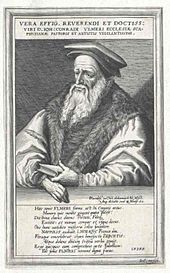Johann Konrad Ulmer
Johann Konrad Ulmer (also from Ulm or in Latin from Ulmis; born March 31, 1519 in Schaffhausen ; † August 7, 1600 ibid) was a Protestant theologian and scholar with many interests. He is considered the reformer of the County of Rieneck and, after Sebastian Hofmeister, the second reformer of Schaffhausen.
Life
Ulmer received his first training at the Latin school in his hometown. In 1537 he went to Basel to study , where Simon Grynaeus took him into his house. Here he heard Oswald Myconius , Bonifacius Amerbach and Andreas Bodenstein . In 1538 he moved on to Strasbourg to Martin Bucer , John Calvin and Wolfgang Capito heard.
In 1541 he traveled to Wittenberg , where he was matriculated on October 7, 1541. Here he studied with Martin Luther and Philipp Melanchthon , whom he held in high esteem throughout his life. In 1542 he received his master's degree , together with Johann Stigel, Johann Crato from Breslau, Heinrich Meier from Bern and others.
In 1543, Count Philipp von Rieneck called him to Lohr am Main to introduce the Reformation . For this he was ordained on November 28, 1543 by Johannes Bugenhagen in Wittenberg. As court preacher to the count, he was very effective. Under his preaching activity, the city and then the entire county went nonviolent to the Reformation. When the county fell to the Archbishopric of Mainz after Count Philipp's death in 1559 , he was allowed to stay with his community. In Lohr, Ulmer married Anna Helferich, the town's daughter, with whom he had nine children.
In 1566 he followed the call of the Council of Schaffhausen and returned to his hometown, where he first worked as minister pastor and from 1569 as pastor at St. Johann and as dean of the Schaffhausen church. He shaped it primarily through the initially controversial introduction of a new catechism (1569), through a new church order (1592) and through the reorganization of the school and scholarship system. He was also valued as a translator of Latin scripts into German and as a poet of hymns. Theologically influenced by Martin Bucer and Philipp Melanchthon, he turned sharply against the doctrine of the Last Supper in the Lutheran Book of Concord , especially against Jakob Andreae . He maintained an extensive correspondence, mainly with his Zurich counterparts Heinrich Bullinger , Rudolf Gwalther and Johann Wilhelm Stucki , but also with Théodore de Bèze in Geneva , Conrad Dasypodius in Strasbourg, Daniel Tossanus in Heidelberg and others. In 1596 he was released from the field service because of old age. Four years later he died on August 7, 1600 at the age of 82.
Works
- De horologiis sciotericis, quotquot in aliquo plano aut aedificiorum aut truncorum describi commode possunt. Nuremberg 1556
- Geodaisia, that is: a thorough report of certain and proven field measurements. Strasbourg 1580 (facsimile edition Schaffhausen 1998).
- Catechism or Kinderbricht, for the churches in the town and country of Schaffhusen, with pure church chants, directed towards each Houptstuck des Catechismi. Zurich 1569.
- Psalms and spiritual songs, which are sung in the churches and schools of Schaffhusen. Zurich 1579.
- Symbola, or the old belief that is: the most ancient acquaintances of the belief from the holy old guarded Councils and Vättern. Basel 1578, Zurich 1583.
- New Jesuwitspiegel, in it through trey beautiful books and a funny conversation, their teaching, faith and life. Basel 1586.
- Christian order and break of the churches in Schaffhausen in the Eydgnossschaft . Schaffhausen 1592.
- Five sermons of the Sacred Sacraments, Alts, and News Testaments. Zurich 1598.
- Consolation writing for troubled and afflicted hearts, which are tormented with the burden of their sins and with dark thoughts of their conscience. Zurich 1579, 1600.
- De Sacramento Coenae Dominicae, Homiliae V. Zurich 1601.
- Digitized works at e-rara (Swiss prints from the 16th century)
literature
- Endre Zsindely: Johann Conrad Ulmer . In: Schaffhauser Contributions to History. Biographies Volume IV . 58th year 1981, pp. 358–369 ( PDF; 407 kB )
- Eduard Scherrer: The first Schaffhausen catechism by Johann Conrad Ulmer and the struggle for the same (1567-1569). In: Schaffhauser Contributions 16 (1939), pp. 179-198.
- Jakob Wipf: Reformation history of the city and landscape of Schaffhausen. Schaffhausen 1929, pages 348-362.
- Günter Opp: Ulmer, Johann Konrad. In: Biographisch-Bibliographisches Kirchenlexikon (BBKL). Volume 12, Bautz, Herzberg 1997, ISBN 3-88309-068-9 , Sp. 883-887.
- lu: Ulmer, Johann Konrad . In: Allgemeine Deutsche Biographie (ADB). Volume 39, Duncker & Humblot, Leipzig 1895, pp. 209 f.
- Rainer Henrich, René Specht: Johann Conrad Ulmer (1519–1600). Completion of the Reformation in Schaffhausen , Chronos, Zurich 2020, ISBN 978-3-0340-1595-0 .
Web links
- Christian Moser: Ulmer, Johann Konrad. In: Historical Lexicon of Switzerland .
- Chronological index of the correspondence of Johann Conrad Ulmer
Individual evidence
| personal data | |
|---|---|
| SURNAME | Ulmer, Johann Konrad |
| ALTERNATIVE NAMES | Ulma, Johann Konrad de |
| BRIEF DESCRIPTION | Protestant theologian and natural scientist |
| DATE OF BIRTH | March 31, 1519 |
| PLACE OF BIRTH | Schaffhausen |
| DATE OF DEATH | August 7, 1600 |
| Place of death | Schaffhausen |
